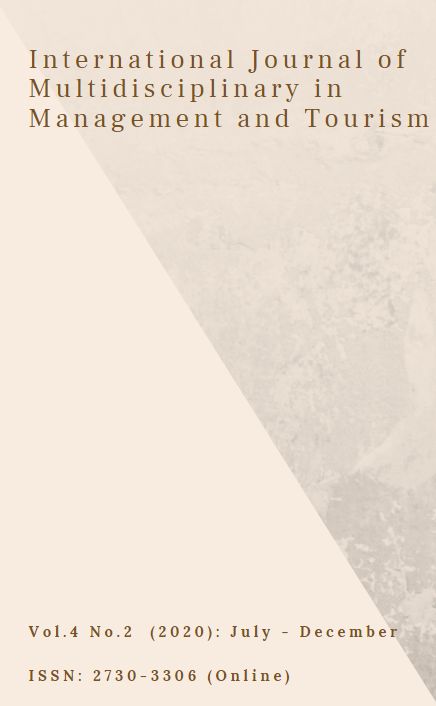The Willingness to Pay of Overseas’ Tourists on Visiting Ecotourism at Phou Khao Khouay National Conservation Area, Vientiane Capital, Laos
Main Article Content
Abstract
This paper is to estimate the Willingness to Pay (WTP) of overseas tourists on visiting Phou Khao Khouay conservation area, Vientiane Capital. The analysis relied on Choice Modeling (CM): Conditional Logit with interaction to seek out to identify the factors that affect the WTP. We used the attribute variables and non-attribute variables to analyze which are Camping, Hiking, Waterfall activities and culture, and religion visiting. On this paper, we subdivide to two types of WTP, first WTP on general conditional logit model, and second is the conditional logit with interaction. According to the sample of 315 respondents, the consequences showed that the WTP of tourists from the first model on the waterfall is the highest which is 74.8 USD, followed by Hiking, Camping and religion, and culture which are accounted for 65.52 USD, 44.02 USD and 32.85USD respectively. The second model, we found that the WTP of tourists on the waterfall is which is 86.27 USD, followed by Hiking, Camping, and religion, and culture which are accounted for 52.82 USD, 39.94 USD and 30.67USD. Based on the analysis, the all socio-economic characteristics of respondents have not statistically significant, it means that the personal characteristics have not directly affected on WTP. These findings do not only support the provision of good and green services in Phou Khao Khuay conservation area but will also be useful for the whole ecotourism in Laos.
Article Details
References
Arrow, K., Solow, R., Portney, P. R., Leamer, E. E., & Schuman, H. (1993). Report of NOAA panel on contingent valuation.
Blackman. A., Naranjo. M. A., Robalino. J. & Aipizar. F. (2014). Does Tourism Eco Certification Pay? Costa Rica's Blue Flag Program. World Development, 58, 41-52.
Campbell, L. M. (1999). Ecotourism in rural community. Annal of Tourism Research, 26(3), 534553.
Fishburn, P. C. (2010, June 17). Utility Theory. Institute for Operations Research and the Management Science, 14(5), 335. Retrieved June 3, 2019
Hearne, R. R., & Salinas, Z. M. (2002). The use of Choice experiments in the analysis of tourist preferences for ecotourism development in Costa Rica. Journal of Environmental Management, 1-11.
Juutinen. A., Mitani. Y., Mantymaa. E., Shoji. Y., Siikamaki. P., Svento. R. (2011). Combining ecological and recreational aspects in national park management: A choice experiment application. Ecological Economics, 70, 1231-1239.
Khamsay, P., Takahashi, Y., Hisako Nomura, & Yabe, M. (2015). Economic Valuation of River Conservation towards International Tourists’ Preferences and Willingness to Pay for Ecofriendly Services of Hotel Industry: A Case Study of Namxong River in Vangvieng District, Laos. Journal of Water Resource and Protection, 897-908.
Kyophilavong, P., & Bennett, J. (2011). Willingness to Pay for Cleaning Road Dust in Vientiane. International Business and Management, 3(2), 12-18.
Mejia. C.V.' and Brandt. S. (2015). Managing tourism in the Galapagos Islands through price incentives: A choice experiment approach. Ecological Economics, 117, 1-11.
Priest, J., Carter, S., & Statt, D. A. (2013). Consumer Behavior. In Consumer Behavior. HERIOt-WATT University.
Schooling, N. I. (2013, February 2). Types and Forms of Tourism. Retrieved from An intiative of NIOS: oer.nios.ac.in/wiki/index.php/forms_of_tourism
SESRIC. (2010). International Tourism in the OIC Countries: Prospects and Challenges. The Statistical, Economics and Social Research and Training for Isamic Conntries. Ankara: SESRIC OIC Ankara Centre.
Sitphaxay, S. (2018). Lao economy annual report. Vientiane Capital: Bank of the Lao.P.D.R.
Steven C, H. (2006). Theory, Policy, and the Sustainable Society. Environmental and Natural Resources Economics, 179.
VOA. (2016, July 19). Lao tourism's stratey forward to 2025. Retrieved from Voice of America: https://lao.voanews.com/a/lao-authorities-draft-strategic-plan-of-national-tourismdevelopment-2025/3424602.html.
Walton, J. K. (2019). Tourism Freetrial. Retrieved June 4, 2019, from Encyclopaedia Britannica: https: www.britannica.com/topic/tourism
Whitington, D. (2002, June). Improving the perfornce of Contigent Valuation Studies in Developing Countries. Environmental and Resource Economics, 22(1-2), 323-367.
Witthink, L., & Haensel, A. (2011). An overview of theory and development in individual choice behavior modeling. Choice Modeling.
Wang, X.J., Zhang, W., Li, Y., Yang, K. Z., Bai, M. (2006). Air quality improvement estimation and assessment using contingent valuation method, a case study in Beijing. Environmental Monitoring and Assessment, 120(1-3), 153-168.
Yu, B., Cai, Y., & Laiqun Jin, &. D. (2018). Effects on Willingness to Pay for Marine Conservation: Evidence from Zhejiang Province, China. Sustainability, 1-17.

